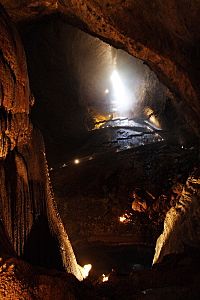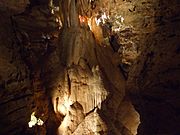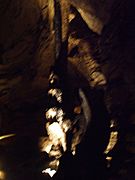Marvel Cave facts for kids
Quick facts for kids Marvel Cave |
|
|---|---|
| Marble Cave | |

Marvel Cave Cathedral Room I
|
|
| Location | Silver Dollar City, Branson, Missouri, United States |
| Depth | 500 ft (152 m) |
| Discovery | 16th century |
| Entrances | 2 |
| Access | private (tours on park operating days) |
| Show cave opened | 1894 |
| Show cave length | 60 minutes |
| Lighting | electric |
| Features | flowstone, stalagmites, stalactites |
| Website | http://www.silverdollarcity.com/theme-park/attractions/rides/Marvel-Cave.aspx |
Marvel Cave is a special natural landmark in Branson, Missouri. It sits on top of Roark Mountain. Native American tribes, like the Osage Indians, knew about the cave in the early 1500s. A tribe member even fell into its main entrance, which is a large hole in the ground called a sinkhole.
Some people believe the Spanish explored the cave in 1541. The first recorded trip into the cave was in 1869. It was led by Henry Taylor Blow. There were also rumors that a local group of people took others to the top of Roark Mountain and threw them into the sinkhole.
The cave was first called Marble Cave. This was because explorers in 1882 thought they saw marble on the cave's ceiling. A company called the Marble Cave Mining Company started because of this. But they later found out there was no marble in the cave. The company stopped working after only four and a half years.
William Lynch bought the cave in 1889. He soon opened it for people to visit. In 1950, Hugo Herschend leased the cave for 99 years. The Herschend family made many improvements to the cave. They later opened a fun theme park called Silver Dollar City right above the cave. Marvel Cave is famous for being one of Missouri's largest caves. It has one of the biggest cave entrance rooms in North America, called the Cathedral Room. It is also one of the oldest tourist attractions in the Ozarks region.
Contents
Exploring Marvel Cave's Past
Early Cave Explorers
There is a story that Spanish explorers came to the cave in 1541. They hoped to find treasures or even the legendary Fountain of Youth. Some legends say the Spanish buried gold inside the cave.
The first recorded trip into the cave happened in 1869. It was led by Henry Taylor Blow from St. Louis. He was a rich lead miner. He explored the cave with six other miners. They used lanterns for light as they went down into the sinkhole. They spent hours looking for signs of lead ore.
They reached a part of the cave called the Shoe Room. They thought a deep pit nearby, called the Gulf of Doom, was bottomless. They threw rocks down it and heard no sound. Another area, the Cloud Room, was full of bat droppings. The miners did not find lead ore. But they thought the Shoe Room ceiling was marble. Because of their report, locals named the cave Marble Cave.
In 1882, another group, led by Mr. T. Hodges Jones and Truman S. Powell, explored the cave. They also hoped to find lead. They found huge amounts of bat droppings and the flat ceiling they believed was marble.
The Marble Cave Mining Company
In 1884, Mr. T. Hodge Jones bought the land around the cave. He and his friends started the Marble Cave Mining and Manufacturing Company. They wanted to mine the "marble" from the cave.
However, a geologist they hired found out the ceiling was not marble. It was actually limestone. To keep the company going, they mined the bat droppings, called guano. They sold it for a lot of money. Guano was used to make gunpowder and fertilizer. Miners filled carts with guano. Donkeys pulled the carts to the Cathedral Room. Then, a pulley system lifted the carts out of the cave. By 1889, all the guano was mined. The company then closed down.
Marmaros: A Ghost Town
Marmaros was a small town that grew near the cave in 1884. It was first called Marble City. It was on a hilltop near the cave. The town had a hotel, a general store, a pottery shop, and a furniture factory. There were also rumors of a saloon.
When the mining company closed in 1889, Marmaros became a ghost town. Later, when the Lynch family bought the cave, a local group of vigilantes known as the Bald Knobbers burned the town to the ground.
The Lynch Family's Legacy
On October 30, 1889, William Henry Lynch bought the cave and the land around it for $10,000. He was a miner and dairyman from Canada. When he arrived, Marmaros was burned down.
William Lynch and his family decided to open the cave for visitors. They started tours in 1894 with a big celebration. The cave has been open ever since. This makes it one of the oldest places to visit in the Ozarks.
When William Lynch passed away in 1927, his daughters took over the cave. Soon after, they changed its name to Marvel Cave. The Lynch family ran the cave for over 50 years.
The Herschend Family's Vision
In 1950, Hugo Herschend, a vacuum cleaner salesman from Chicago, leased the cave for 99 years from the Lynch sisters.
After Hugo Herschend died in 1955, his wife Mary took charge. With her two sons, Jack and Peter, Mary Herschend made big improvements to the cave. They added concrete paths and stairs. They also built a tower from the sinkhole to the top of the debris pile.
In 1957, they added a special narrow gauge funicular (a cable-pulled train). This train takes visitors 218 feet (66 m) from deep inside the cave up to the surface. The United States Army Corps of Engineers thought it couldn't be built because of a turn the Herschends planned. But the Herschends built it anyway, and it still works today!
Once the cable train was ready, the Herschends decided to rebuild the old mining village of Marmaros. This new village was for tourists waiting for cave tours. It opened in 1960 and is now known as Silver Dollar City.
In 1972, Genevieve Lynch died. She left the cave to the College of the Ozarks and the First Presbyterian Church of Branson. The Herschend family still operates the cave under their lease.
Marvel Cave Tours
Today, you can choose from two different tours: the Traditional Tour and the Lantern Tour.
Traditional Cave Tours
The first guided tours started in 1894, run by the Lynch family. These tours lasted 8 hours! Visitors climbed down a 100 feet (30 m) ladder into the sinkhole. Then, they slid down a pile of debris to the bottom. Everyone got a candle to light their way.
These early tours included rooms like the Egyptian Room (now the Shoe Room) and the Lakes Passage. You could see formations like the Great White Throne (now the Liberty Bell). After the Herschends took over in 1950, they replaced the wooden stairs with concrete ones. Current tours last about an hour and are limited to 60 people.
Lantern Light Tours
In 2006, Marvel Cave began offering the Lantern Light Tour. For this tour, the electric lights in the cave are turned off. Each person gets a lantern. Unlike the regular tours, this one costs $16.12 and is limited to 20 people.
This tour goes into the Mammoth Room, which was not part of tours for over 50 years. You might also see the summer and fall sections of the Waterfall Room, if it's not flooded. The tour lasts about an hour and a half. The guide shares more about the cave's history and old stories because the group is smaller.
Amazing Rooms and Passages
- The Cathedral Room is one of the biggest cave entrance rooms in North America. It is 204 feet (62 m) high, 225 feet (69 m) wide, and 411 feet (125 m) long. You enter the cave through a sinkhole that is 94 feet deep. Rocks, trees, dirt, animals, and falling boulders have created a pile of debris 124 feet (38 m) tall. This pile is sometimes called the Underground Mountain. In 1963, Don Piccard flew a hot air balloon around this huge room. In 1994, five hot air balloons flew in the Cathedral Room at the same time to celebrate 100 years of cave tours.
- The Mammoth Room is where most of the bats sleep during winter. In 1869, Henry Taylor Blow found Spanish-style ladders here. These were small trees with notches carved into them.
- The Dungeon is a passage next to the Cathedral Room. You can enter through a small crack 80 feet (24 m) below the sinkhole entrance. The walls have blood-like stains from lots of iron oxide. This made early guides say it was a torture place for Spanish explorers. This passage also connects to the Mammoth Room.
- The Lakes Passage is past the Mammoth Room. It has two lakes named Genevieve and Miriam, after William Lynch's daughters. Divers have explored these lakes and found underwater passages. They went as deep as 110 feet (34 m). These long lakes were once thought to be a river. Genevieve Lynch later explored the passage and found that the water-filled parts ended. Her group found that the cave continued uphill. This passage has been explored, but not completely. The last room found is a tall pit with two small waterfalls, making it hard to climb.
- The Spring Room is behind a tall column called the Sentinel. This room is covered in orange calcite. It has several waterfalls that sound like falling rain. Legends say the water here is magical, possibly the Fountain of Youth.
- Serpentine Passage connects the Cathedral Room and the Egyptian Room. It shows how water used to flow through the cave.
- Egyptian Room / Shoe Room Genevieve and Miriam Lynch loved studying Egypt. This flat, smooth, desert-like room reminded them of a pyramid. They saw shapes in the rocks that looked like King Tutankhamen's Sarcophagus, the Sphinx's Nose, and Cleopatra's Sandal. The ceiling looks like a large sandal or shoe, which is why some call it the Shoe Room. This flat, smooth ceiling was once mistaken for marble.
- The Gulf of Doom is under the "heel" of the shoe-shaped ceiling. People once thought this big pit was bottomless. They would throw rocks into it, but heard no sound. Superstitious people thought it was a gateway to the underworld. But the real reason was simple: lots of clay and bat guano covered the bottom, over 100 feet below.
- Cloud Room or Cloud Land has a rough, bumpy ceiling. The ceiling is made of dolomite and looks like low-hanging clouds.
- Tall Man's Headache / Fat Man's Misery is the smallest passage on the guided tour. It has a low ceiling and narrow sides. It is about 4 feet (1.2 m) 7 inches (18 cm) tall and 7 feet (2.1 m) long.
- The Harold Bell Wright Passage is before the Waterfall Room during fall and winter tours. Harold Bell Wright, who wrote The Shepherd of the Hills, was friends with the Lynches. He sometimes stayed in the cave for days. There is a cabin in this passage where he stayed. Some believe he wrote parts of his book there. Inside the cabin, he painted a picture of a character from his book, Maggie. The cabin there now is a copy, but it uses some of the original wood.
- The Waterfall Room is the lowest room on the tour, 505 feet (154 m) below the surface. The water comes from an underground stream called The Lost River. This room can fill with water all the way to the ceiling when it rains a lot.
- The Mud Passage is between the Waterfall Room and the Mystic Pool Room. It was named for the mud found there during early tours, which has since been cleaned out.
- The Mystic River Passage is a small, water-filled passage. It eventually opens into the second largest room in the cave, called the T Room. The cave continues beyond the T Room, but the passage gets much smaller and narrower. To enter, you have to lie on your back with your face above the water. It is very tight and full of mud and water, so some call it the "Sewer Pipe." The very end of this passage has not been reached.
- The Mystic Pool Room is the room where the Mystic River Passage is located.
- The Elves Chamber is the top part of a pit that goes up from the Mystic Pool Room. You can see many calcite formations here. The ceiling is full of long stalactites and covered in helictites. The entrance to the Cable Train Tunnel is in the Elves Chamber. This makes it the last room on the Marvel Cave tour.
Cool Cave Formations
- Blondie's Throne is a flowstone near the end of the cave tour. It looks like a throne. The name "Blondie" comes from a story about a boy named Charles Smallwood. He got lost in the cave a long time ago. He was found sleeping near this formation. The first thing they saw in the candlelight was his blonde hair. There's a legend that something in the cave turned his hair blonde, but it's more likely he was just known for his blonde hair.
- The Liberty Bell is a 55 feet (17 m) tall stalagmite. It started as a stalactite on the ceiling near the Serpentine Passage. It's named for its shape and a crack on its side. The crack happened when it fell from the ceiling. Now it's on the cave floor and continues to grow there. It's hollow and can fit four to five adults inside. It was first called "The Great White Throne."
- The Sentinel is a column in the Cathedral Room. It's right in front of the passage to the Spring Room. It used to be called "The Spring Room Sentinel." Tour guides also say it's the only thing holding up the dome of the Cathedral Room.
Life Inside the Cave
Marvel Cave is home to many different kinds of bats and salamanders. The cave is known for its great work in protecting its group of endangered Gray Bats.
- Bats
- Salamanders
- Cave Salamander
- Grotto Salamander





